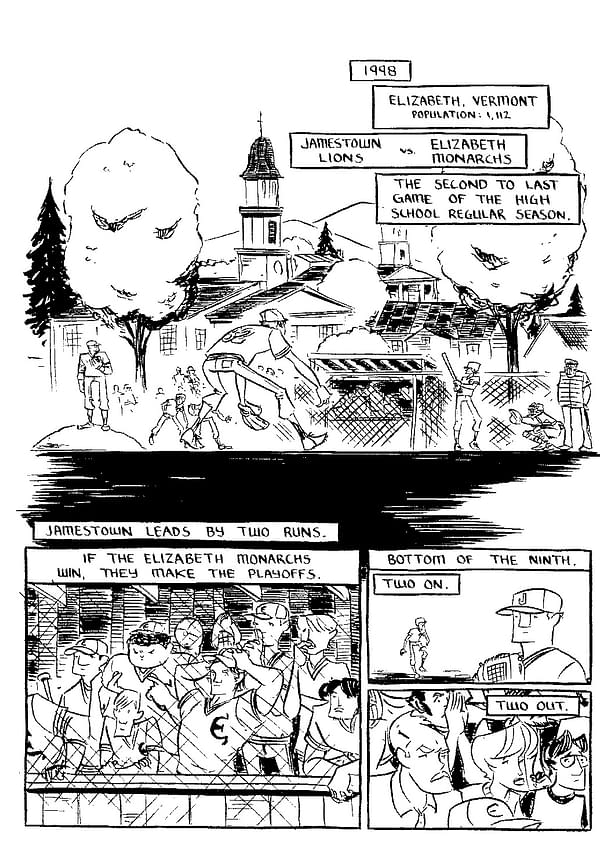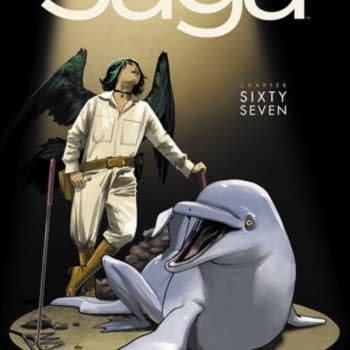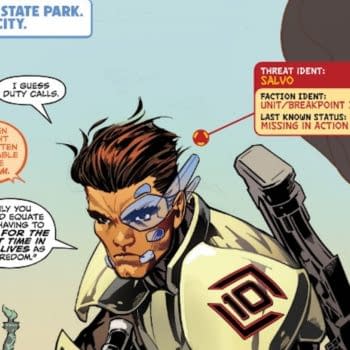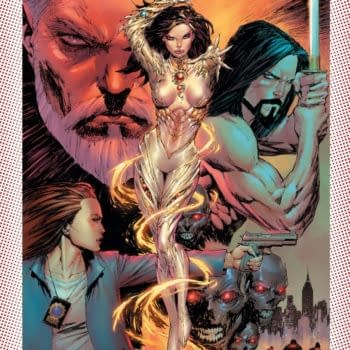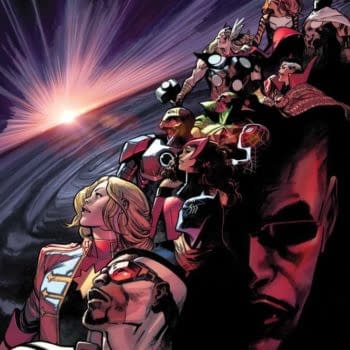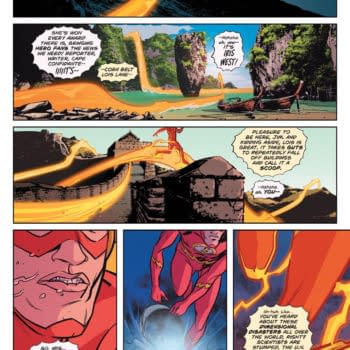Posted in: Comics | Tagged: Comics
A Dog Named Indie: Jesse Lonergan
Louis Falcetti writes;
Welcome back to another edition of A Dog Named Indie, where I'm going to be bringing the world of independent comics to you for the benefit of both of us. I spent most of my life as a comic book reader almost totally ignorant of indie comics, beyond the "big" names that cross into the mainstream like Pekar or Crumb. Now that I'm up to my eyeballs in it I can tell you that it's not as scary as you may think. It's also not pretentious, hard to understand, overly weird or boring. It's just stories and you'll be better readers by reading different authors and hearing different voices. I'm not slagging off capes and cowls comics and I wouldn't even launch into my usual out of nowhere anti-DC screeds, (this Wednesday I'm actually picking up 3 DC books, so there ya go), I'm saying the two can totally co-exist and should. Vote with your wallets babies, don't just complain to no one about nothing. You want better books in the stores? You want better art? Find it. It's out there. Support it and it'll support you. Art is wonderful like that.
For this edition, I'm doing something a little different than in the past (and something I hope to continue into the future) and including the first 6 pages from Chapter One of All Star. It struck me while I was working on this column that the way I've been setting these up, I'm asking you to read about artists you don't know with comics you've never read. Now hopefully when the column is over you know the artists a little better but I can't blame you for not wanting to take a chance and purchase something sight unseen, in this economy. So from here on out (and depending on the permission of the artists I work with, of course) I'm going to be including some preview pages so that you can see for yourself what I'm talking about and hopefully get you over the hump as it were to discovering and experiencing some of the amazing indie magic that's happening all around you.
I first encountered Jesse Lonergan's work at the Boston Comic Con last year. I was immediately impressed with his unique, graceful style, smart ear for dialog and honest, natural approach to storytelling. I've stayed in touch with Jesse as the year has gone on and was lucky enough to pick up Chapters One & Two of his new series All Star while at SPX this year.
All Star takes place in a magical time known as the late 90s, when Mike Meyers was still funny, M. Night Shymalan was still relevant and a little band named Smash Mouth was winning hearts and minds across the country. The story takes place in Vermont and is centered around two brothers Carl and Doug Carter, who are both athletes in a family where such activities are so serious that I doubt they'd say they "play" sports.
This isn't a sports comic though. This isn't like a Matt Christopher novel with pictures. (50 Catcher With A Glass Arm fans just punched the sky) I'm not a sports fan, in fact, I'm one of the guys in the comic shop every Wednesday, losing his shit when dudes won't shut up about football. I never understood the nerd/sports cross over and how so many die hard comics fans are also huge baseball or football fans. It's almost as if people have more than one side to them and can enjoy a variety of different things simultaneously. Imagine that. So believe me when I say that even if you don't know the difference between an RBI and an AFC, you'll enjoy All Star.
All Star hits the reader on all fronts, with enough well written characters to be able to convey a veritable myriad of emotions and experiences in honest, simple terms. It's a testament to his abilities as an artist and story teller. More than that, it's the kind of story that needs to be shared, because dramatic (and at times genuinely funny) comic stories are important to our development as artistic, emotional creatures. We all have stories in us and we have to stop feeling limited by how we can tell them. A serious comic doesn't have to be about war atrocities or substance abuse. Comics can capture the whole range of human experiences and show you the world as you've seen it or would like to see it. All Star hops boundaries as it moves, excites and delights. Read the interview, read the preview pages and get in on the indie scene because it's quite lovely and ready to meet you.
As an artist have you always been in love with movement? From your Dancer A Day Blog to the everyday ballet of school, sports and family in All-Star, it's clear that you love to draw movement. It gives your comics their own unique flow and grace.
My first comics were the Asterix comics, which have this fantastic movement in them. I read a copy of Asterix and the Great Crossing over and over, so much that the cover fell off. Calvin and Hobbes was another one. Bill Watterson was just a master. I can remember staring at the cover of the Essential Calvin and Hobbes Treasury with Calvin being hit by Hobbes when he came home with the shoes flying off. I still love it.
In terms of the movement in my own drawing, this may sound strange, but I think it comes from trying to draw quickly. I've always been frustrated by how long it takes to draw a page. Spending two days on a page that someone will look at for under a minute just seems like a terrible waste. I've always wanted to draw with more speed, and this speed has led to my line work being pretty loose and pretty energetic. It's kind of like my hand is dancing while I'm drawing. A reader can see this quality in the lines, and it's this quality that gives the characters movement.
-How much of All-Star is autobiographical?
Naturally, the story was inspired by real places, people, and events, but All-Star is my least autobiographical book so far. The characters and events are almost entirely fictional. The only thing that I would say is factual is the town, which is based on the town I group up in. I gave it the fictional name Elizabeth, but really it's Chelsea, Vermont. The panel backgrounds are pretty accurate. That's my high school. That's the local store. Those are the basketball courts with the law office across the street. If you've been to Chelsea you'll recognize the places in the book.
-How long are you planning to make All-Star ? I ask because Chapter 1 packs so much narrative and characters into it, then the majority of Chapter 2 takes place at the practice (I almost called it "rehearsal field" telling you how much I know about sports) with the brothers. Not that I'm complaining, I love the pacing, I'm just curious to whether or not you had a vision for how long it's going to take to tell this story.
I think in the end it will be around 150 pages. Chapters 1 and 2 are really laying a lot of groundwork for what's to come. Most of the feedback I've gotten from those two chapters has been really positive, which has made me feel good because the first real plot point doesn't come until Chapter 3. With Chapter 3 the story really kicks into high gear. The story takes a turn that people won't expect in Chapter 3.
-In your artistic career have you primarily illustrated your own scripts or have you mostly drawn the writing of others? I've always wondered if it's difficult for directors who are also actors, like John Cassavettes or John Huston, to go from controlling everything to having to essentially take orders from someone else. Has your experience writing comics changed the way you work on other people's scripts? Do you think "I can't believe they want me to draw this" or is it more collaborative than a director on a film set?
Working with a writer is incredibly liberating. I don't have to worry about the story or pacing. My job is just to do the drawings as well as I possibly can, so I push myself a lot more artistically. It's also great because the stories that I am drawn to as an artist and the stories that I am drawn to as a writer aren't always the same thing. Other people's stories are like a whole new box of toys.
-I was in high school in the 90s, so now that stories are being told in that time period it wigs me out a little bit, how I viewed Gen X'ers after watching Dazed and Confused, I think, that's me now to some younger dude. All-Star really creates the feeling of that time so well. How do you prepare to tell a story in the 90s? Do you have to immerse yourself in Gin Blossoms and Full House episodes?
I totally made a playlist with a ton of late 90s bands on it: Semisonic, Fastball, OMC, White Town, 4 Non Blondes, Third Eye Blind, Spacehog, Savage Garden…
I also dug through my old yearbooks, just looking for stuff that would remind me of that time. I ultimately settled on 1998 because of the Mark MacGwire/Sammy Sosa home run chase, which I feel serves as a nice counterpoint to the story that I'm working on.
The reason I chose the 90s is because that was when I was a teenager. There's been such a sea change since I was in high school that I don't even know if I could write a story about teenagers now. The technology that is so normal just didn't exist in 1998. There was no Facebook. Nobody I knew had a cell phone. Text messaging was unheard of. I'd have to do some serious research to do a book about teenagers now.
-Is All-Star a sports story? How important is sports to the story? How important is baseball in particular to the story? Is this a sports story first or a coming of age story? Or a family drama? How would you overly simplify all the complex themes and characters in All-Star?
All-Star is primarily a coming of age story. Baseball and the fact that Carl is a superstar are key to the story, but the most important events take place off the field. There are a lot of themes in All-Star, but I think most dominant is the idea of fairness or unfairness. There are kids who get second chances, sometimes third chances. There are some kids who get fifty chances. They can screw up all they want and still come out okay (perhaps a former president could serve as an example of this). Then there are kids who get one chance, and if they blow it, it's gone. That's it. The difference between those who get multiple chances and those that get one is what All-Star is about.
-I appreciated the Norm MacDonald discussion, I know for a fact that I had that exact same conversation word for word. No question here, just needed to commend you on that.
I love Norm MacDonald, and he seemed like a perfect celebrity to lock the story in place time-wise. Another one would be Pauly Shore, but I always thought Norm MacDonald was funnier.
-Is this the kind of material that you want to focus on as an artist? Slice of life, real world dramas or do you think you have some more genre type stories in you as well?
I definitely want to experiment. Slice of life and real world dramas interest me, but so do post-apocalyptic action adventures. There is so much that I want to do. I think I add to the list every day.
-How is the Dancer A Day Blog going? How do you choose the characters that you use? Are you planning on doing anything with them, like a calendar or tee shirts, or is this more for you simply staying in the habit of daily work?
It's awesome. I love doing it. I originally planned to do it for only one year, but right now I see no reason to stop. Drawing the characters is great, but I also feel like it has gotten me drawing faster, drawing with more confidence and more focus, and I've gotten to meet people through it. Just this week a person sent me a dancer they had drawn in the mail.
I get a lot of requests for dancers, which helps me decide. If there's a movie coming out that I'm excited about (The Hobbit?), I might do a themed week. Sometimes, it's just whoever I feel like drawing that day.
At the moment, the dancers are just on the blog, but I have done some prints and sold originals. I'm not sure about a book or calendar, at least on any large scale. I have a feeling there might be some copyright issues.
-Does All-Star say where the story takes place? For a story like All-Star is it important that this take place in New England rather than Wisconsin?
The story takes place in Elizabeth, Vermont, which is a fictional stand-in for my hometown. For readers, I don't think it's really important that the story is set in New England. The core of the story could take place anywhere.
As a writer, it's incredibly important. New England is where I grew up. I know this place, the towns, the people, the weather, the snow plows in winter, all of it. It's home. You can ask me to draw a typical New England town, and I can do it without even having to think about it (I'd start with a white church). I don't know Wisconsin. I don't know what the towns look like, what people do for fun, or even what the common last names are. If you asked me to draw Wisconsin, I'd just be guessing.
I can write a story set in New England with complete confidence. No doubts. I think readers can feel that. They have bullshit detectors. It's like knowing someone is lying. You might not know why they are lying, you might not know what the truth is, but you still know they are lying.
-What are you working on next? Where can people go to find out more about your work?
I have three different ideas for the next big book, and which takes preference in my mind really depends on the day. One is a mystical/supernatural western story of vengeance from beyond the grave. Another is a hyperbolic non-stop rock and roll story, which would be an expansion on my mini-comic The Sex Sex. The last would be a collection of short stories. I have this huge pile of comics that I have done that I think should see the light of day, but the styles with which they have been drawn are completely inconsistent, so I'd like to put them together into a coherent whole.
But I think after the completion of All-Star there will definitely need to be a period of mind-clearing and experiment. One of the frustrating things about working on a big book is that it really feels like I should only be working on the big story. It requires focus, which is good, but it doesn't allow for much creative meandering, which is important too.
To find more of my work, danceraday.tumblr.com is updated every day Monday through Friday, and jesselonergan.blogspot.com contains all sorts of stuff, stories, runs of daily comics, doodles, one off drawings, reviews, process stuff. There is also my etsy store: http://www.etsy.com/shop/ShopLonergan, which has a bunch of mini comics, including the first two chapters of All-Star, and the third one is coming soon. And there is Amazon, where people can pick up my first two graphic novels, Flower and Fade and Joe and Azat (of course, people could also go to their favorite local comic shop and bookstore, see if they are there, and if not, order them and support local business).

